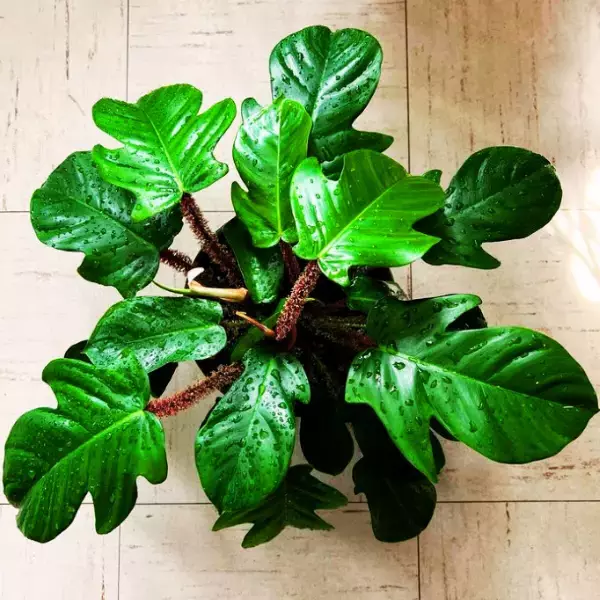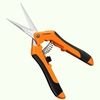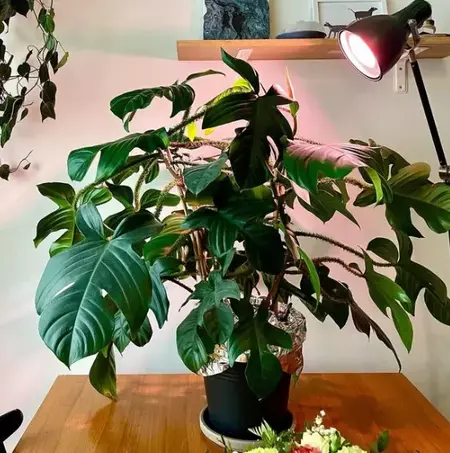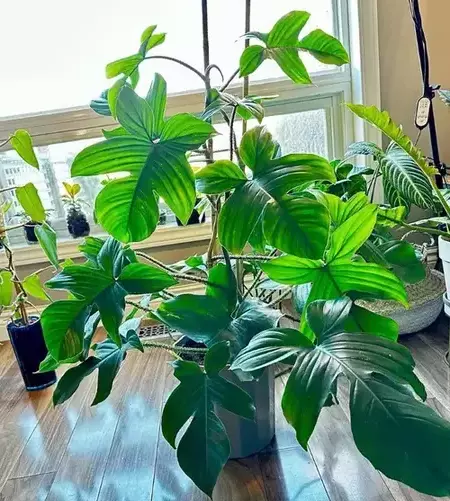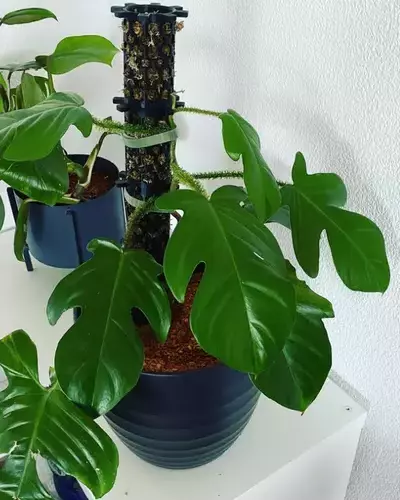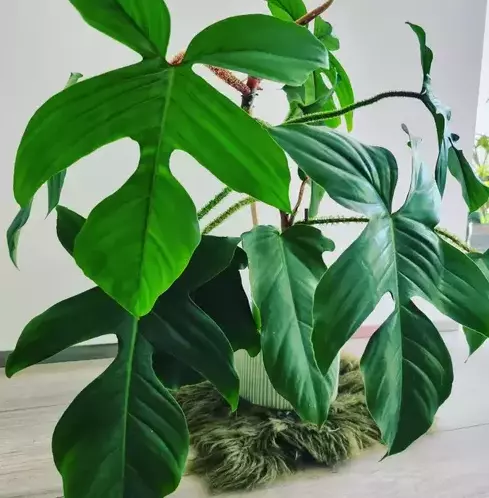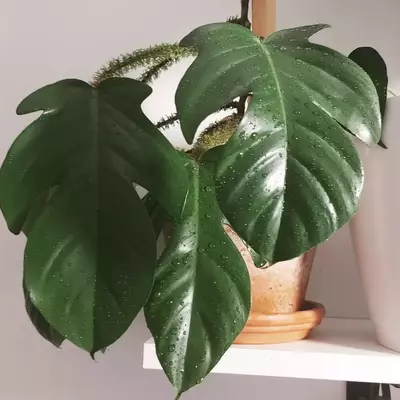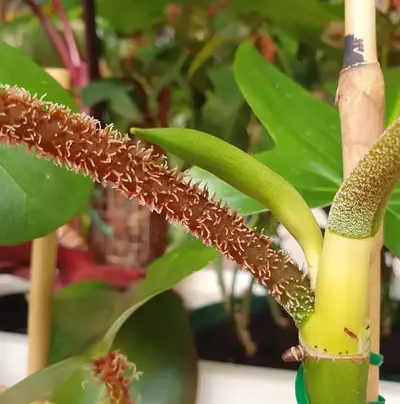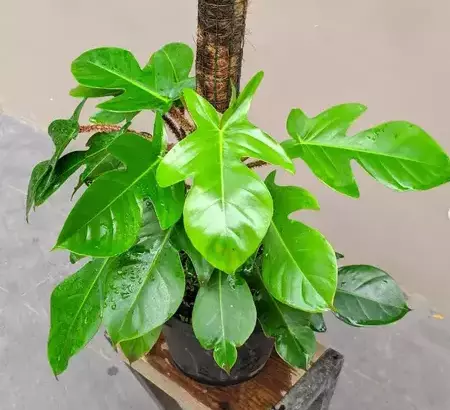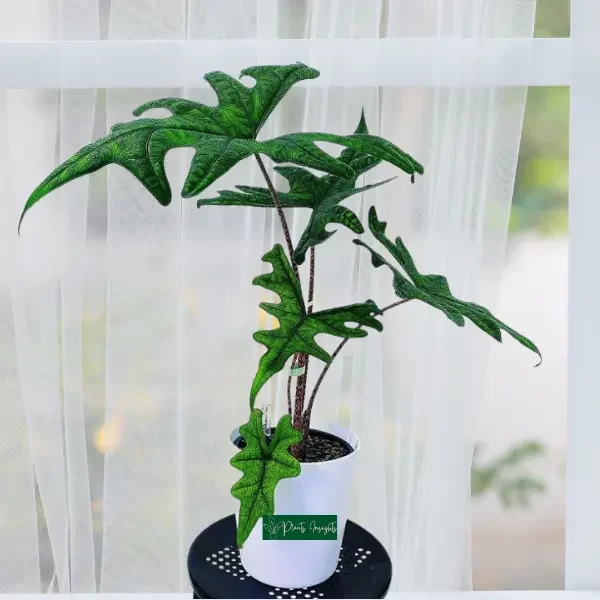Welcome a stunning ornamental foliage plant of the Philodendron genus- the Philodendron Squamiferum, an exotic plant that will surely steal your heart with its unique and captivating appearance. This rare species of Philodendron, also known as the “hairy” or “red-bristle” Philodendron, is native to the rainforests of Central America, French Guiana, and Brazil, where it grows as an epiphyte, clinging to the trunks of trees. With its long, lush foliage and striking red-brown stems covered in soft, hair-like spines, the Philodendron Squamiferum is a true work of art that will bring a touch of the wild into your home.
But beyond its aesthetic appeal, the Philodendron Squamiferum is also a symbol of resilience and adaptability. It has evolved to survive in the harsh, unpredictable conditions of the rainforest, and with the proper care, it can thrive in any indoor environment. So why not embark on a journey with the Philodendron Squamiferum, and bring the wild beauty of the rainforest into your home?
Closely-Related Allied Species: Philodendron Florida Ghost, Philodendron White Knight, Philodendron White Princess, Philodendron Moonlight, Philodendron Verrucosum, Philodendron Mamei
Essential Products
Origin and Family
| Botanical Name: | Philodendron Squamiferum |
| Family Name: | Araceae |
| Other names: | Red Bristle, hairy Philodendron |
| Plant Type: | Perennial |
| Origin: | Central America, French Guiana, and Brazil |
| Color: | Dark green |
| Leaf Shape | large lobed leaves |
| Humidity: | 60% or more |
| Temperature: | 65°F to 85°F (18°C to 29°C) |
| Light Need | Partial shade; Bright, indirect light |
| Propagation | Stem cutting |
| Soil type | Coarser, lighter, well-drained, rich in organic matter |
| Preferred PH | Moderate to Slightly acidic (5.6 to 6.5) |
How do you take care of Squamiferum?
This remarkable beauty’s care requirements are no different from any other common houseplant. The most critical factors regarding Philodendron Squamiferum plant care are light, soil type and drainage, and humidity.
For Philodendron Squamiferum to thrive in its new home, you must remember a few key steps during its initial care. First, find a spot with bright, indirect light, as direct sunlight can scorch the leaves. Next, ensure the soil is well-drained and consistently moist but not waterlogged to prevent root rot.
Maintaining a warm, humid environment is essential, as the Philodendron Squamiferum is a tropical plant and thrives in warm temperatures. With these simple steps, your Philodendron Squamiferum will be on its way to becoming a stunning centrepiece in your indoor jungle.
Below are more comprehensive details about Philodendron Squamiferum care.

Growth and Size:
The Philodendron Squamiferum features velvety, heart-shaped leaves that can grow up to a foot in length, creating a stunning display of greenery that will leave you in awe. And the striking contrast between the bright, lush leaves and the spiny, reddish-brown stems is mesmerizing.
One of the most noteworthy characteristics of the Philodendron Squamiferum is its ability to grow very tall, often reaching impressive heights when climbing up tall trees in its natural habitat. While a young plant may only measure around 15 inches in height, its leaves can become lengthy when fully matured. Even a single leaf on a mature Philodendron Squamiferum plant can reach 18 inches long.
Despite its impressive size potential, the Philodendron Squamiferum has a relatively modest growth rate compared to other tropical plants, such as the Monstera deliciosa. Although it can grow quite large over time, it is unlikely to take over your home or garden too quickly.
However, it is essential to signify that the Philodendron Squamiferum is a tropical plant that requires a warm, humid environment to thrive. If you are considering growing one, provide adequate water, light, and humidity to ensure its health and growth.
Is Philodendron Squamiferum a climber?
The petioles of Philodendron Squamiferum are covered in coarse hairs that gradually develop a reddish color as they mature. Like most Philodendron varieties, this plant is a climbing vine that benefits from growing up with support such as a moss pole, totem, or trellis.
This allows the plant to spread out and climb upwards, giving it more room to grow and flourish. Providing a suitable support structure can help your Philodendron Squamiferum thrive and reach its full potential.

Watering
Watering is the most critical aspect of Philodendron Squamiferum growth. It thrives in moist soil as a tropical plant, but it’s important not to overwater it as this can lead to root rot.
To ensure that you are watering your plant correctly, allow the top inch of soil to dry out slightly between waterings. Insert your finger into the soil to determine when to water your plant. If it comes out dry, it’s time to water. Using a moisture meter or moisture sensor is quite helpful in examining soil desiccation if you are not sure.

Once the top soil dries, water your plant thoroughly, and wait until the excess water drains out from the drainage holes to prevent any root rot or fungal disease.
Compared to other Philodendrons, Squamiferum is more sensitive to overwatering, so be cautious not to overdo it. Standing water can accumulate in the bottom of the pot and promote the development of root rot, damaging your plant.
The exact water requirements of your Philodendron Squamiferum depend on several factors, including the pot size, the type of environment it’s kept in, the type of soil medium used, and the light conditions.
Suppose your plant is kept in a brightly lit space and planted in a well-draining potting mix with temperatures between 59- and 75 degrees Fahrenheit. In that case, it’s recommended that you water your plant thoroughly every week or so during the summer months and every 10 to 15 days in the winter.
Paying attention to the soil’s moisture levels and adjusting your watering schedule accordingly can help your Philodendron Squamiferum thrive and grow into an impressive tropical plant.

Light Needs
As a native jungle plant, the Philodendron Squamiferum requires indirect access to sunlight. Keeping the plant away from direct sunlight is essential, whether kept indoors or outdoors. If you are growing the plant outside, it’s best to plant your Squamiferum under a tree canopy or shaded area.
For plants grown indoors, place them near a well-lit window such as an east-facing window or a glass door where your plant can receive gentle morning sun rays. In case you place your plant in south or west-facing windows, use sheer curtains to filter intense direct light during the day that may burn the foliage.
Without access to natural sunlight, you can also consider adding LED grow lights to help the plant thrive. Without adequate light, the leaves of the Philodendron Squamiferum can turn pale and yellow, and the entire plant can become leggy. Also, direct bright sunlight can scorch its leaves. Therefore, it’s vital to ensure that the light is always optimal for the plant to promote healthy growth.
You can help your Philodendron Squamiferum reach its full potential by providing the right growing conditions.
If you notice tiny yellow or brown spots on the leaves, chances are the sunlight is intense for the foliage, and you need to move your plant a few feet away from the window.

Humidity
As a tropical plant, the Squamiferum requires high humidity levels to grow appropriately, similar to its natural habitat in the jungle. To achieve the ideal humidity level of 60% or more, you can group your tropical plants, increasing the the local humidity level around the plants due to transpiration.
Using a plant humidifier is another effective technique to increase humidity, as is manually misting around the plant.
Placing a pebble tray half filled with water and putting the pot on top to increase the humidity is another effective way to increase humidity. Moreover, you can place your plant in the bathroom or kitchen where it is more humid.
Temperature
Temperature is also a critical factor in the growth of Philodendron Squamiferum. To thrive, the plant requires a temperature range of 65 to 85 degrees Fahrenheit. Exposure to temperatures outside of this range can be harmful, particularly if the exposure is prolonged. If you live in areas with USDA hardiness zones 9b to 11, you can grow this plant outdoors
It’s essential to remember that Philodendron Squamiferum has limited temperature tolerance, so extreme conditions like cold and hot drafts should be avoided. In addition, sudden temperature fluctuations as the frigid environment is detrimental to your plant.
Bring this plant indoors in the fall when the temperature drops below 50F at night. Moreover, using heating pads and frost blankets during winter helps maintaining the optimal temperature.

Soil Requirement
The roots of Squamiferum require good drainage and aeration to develop properly. If the potting soil is too dense or compact, it can result in root rot, which can be fatal for the plant. A light and porous potting mix with good drainage is ideal for Philodendron Squamiferum, as it allows air to circulate the roots and prevents water from accumulating in the soil.
A nutrient-rich soil mix is also vital for the lovely Squamiferum. As a slow-growing plant, it requires a steady supply of nutrients to support its growth and maintain its health.
Adding organic matter to the soil can provide the necessary nutrients for the plant to flourish. Additionally, you can fertilize the plant every 2-3 months during the growing season with a balanced, water-soluble fertilizer to ensure it has access to all the essential nutrients it needs.
It would be best to use the following recipe to get a light and porous potting mix with good drainage and aeration for your Philodendron Squamiferum
- House plant potting mix 25%
- Orchid bark 25%
- Perlite 25%
- Coco Coir or Peat Moss 15 %
- Worm castings 10%
- Activated Charcoal
Besides that, you can also choose from our recommended potting mixes available in the market, such as:

Repotting
Like all other Philodendrons, the Squamiferum requires repotting every 1-2 years. But how would you know that your plant wants to be repotted? Don’t worry; this exquisite beauty will show you the signs of repotting.
When the roots start coming out of drainage holes, and the growth has become a bit slower, it’s time to transfer the plant to a new home. The best time for repotting is the active growing season.
The best time to transplant the plant is in spring or summer as it’s a growth season and may help to adjust the plant to a new place.
When repotting Philodendron Squamiferum, prepare the plant by watering it 1-2 days before repotting to make the removal from the old container easier.
Step-by-Step Guide

Philodendron Squamiferum Propagation
Philodendron Squamiferum can easily be propagated via stem cuttings and air layering with 99% success rate.
Stem Cutting Propagation
I prefer stem-cutting propagation for this climbing philodendron as this is simple and has a high success rate. As the leaves are enormous, single-node cuts are just fine for propagation.
Follow a step-by-step guide for Philodendrons Squamiferum propagation via stem cutting.
Propagation in Water
For a Squamiferum’s cutting with very little roots, I usually put it in water because it does need to absorb more water to support the leaf and the new node from where new vine will appear.
Propagation in Sphagnum Moss and Potting soil
You can also use sphagnum moss and aroid potting mix for rooting your cuttings. I prefer using sphagnum moss for cuttings that have a little bit of roots and potting mix directly if they already have a lot of roots.
Before putting your cuttings in sphagnum moss or potting mix, you might need to seal the edge of your cutting by applying cinnamon powder, anti-fungal powder, or activated charcoal to prevent rotting.
Choose a small plastic pot, put the Squamiferum’s cutting in it, and cover the node with a little potting mix. You don’t want to bury the node too much in the potting mix as it will increase the incidence of over-watering.
Therefore, only put like half a pot of potting mix, and when the new vine comes up, you can always add more potting soil later.
When you pot the cutting in potting mix, please ensure the growing eye is facing up so that the growth can find its way up and continue growing leaves facing up.
Air Layering Propagation
Philodendron Squamiferum grows aerial roots along its stem and can be propagated using air layering method. However, this is less common method but possible if you don’t want to cut your plant.

Fertilizing
Feeding your plant with high nitrogen-based all-purpose liquid fertilizers diluted to half strength once a month is ideal in the growing season, while the fertilizer’s frequency should be reduced in the colder months.
Moreover, some plant parents prefer granular slow-release fertilizer as it is also very effective for its growth and reduce the chances of foliage and root burn.
If you are new to plant parenting I highly recommend trying Miracle-Grow Indoor Plant Food Spikes. These pellets are really easy to use and will not burn any foliage of your plant.
Here are some good fertilizers for your Philodendron available on the market:
- Philodendron Plant Food, Indoor Plant Food Liquid Fertilizer
- Liqui-Dirt Nano Powder All-Purpose Organic Plant Food
- Osmocote Smart-Release Plant Food
As a slow grower, this Philodendron requires regular fertilization, but it’s important to note that over-fertilization won’t speed up the growth but can harm Philodendron Squamiferum. Moreover, too much fertilizer can lead to the buildup of salts in the soil, which can damage the plant’s roots and cause leaf burn.
Therefore, following the recommended dosage and frequency of application of specific fertilizers is essential. It’s also essential to ensure the soil is moist but not waterlogged before applying fertilizer. You can water the plant lightly before and after fertilizing to help distribute the nutrients evenly and prevent fertilizer burn.
Finally, it’s important to read and follow the instructions on the fertilizer package carefully. Different fertilizers have different instructions, so use the correct amount and feed your plant the right amount at the right frequency.

Pruning and Maintenance
In addition to aesthetic reasons and size control, pruning can also be necessary for the health of your Philodendron Squamiferum. If you notice any signs of disease or pest infestation, it’s essential to remove the affected parts of the plant promptly to prevent the problem from spreading. Pruning can also stimulate new growth and branching, which can help keep your plant looking full and healthy.
When pruning, using sharp and clean tools is essential to prevent damaging the plant and introducing infection. Before making any cuts, disinfect your pruning shears or scissors with rubbing alcohol.
After pruning, you can spray the plant with water and wipe off any excess moisture to prevent the growth of bacteria or fungi.
Remember, Philodendron Squamiferum is a slow grower and doesn’t require frequent pruning. However, suppose you notice any yellow or dead leaves, signs of disease or pest infestation, or simply want to control the size and shape of your plant.
In that case, pruning can be a helpful tool in keeping your Philodendron Squamiferum healthy and looking its best.

Toxicity
Due to calcium oxalate crystals, Philodendron Squamiferum is poisonous to humans and pets. Consumption of this plant can result in mouth and skin irritation, skin allergies, rashes, stomach discomfort, and in severe cases, difficulty breathing. Keeping this plant out of the reach of children and pets is advised.

Diseases & Pests
While Philodendron Squamiferum is generally a low-maintenance plant that is easy to grow, there are still some issues that you may encounter.
Diseases
Fire Blight or Erwinia Blight
During the summer, one of the most common diseases affecting Philodendrons is Erwinia blight, also known as fire blight. This disease is caused by a bacteria that attacks the soil. The first symptoms of Erwinia blight include water-soaked lesions on the foliage, which can quickly spread to other leaves and parts of the plant.
To control Erwinia Blight disease, you can take several measures, including using surface disinfectants such as bleach on your gardening tools, lowering the humidity levels around the plant, and reducing watering frequency. These steps can help prevent the spread of the bacteria and protect your Philodendron from further damage.
Fungi and Root Rot
Excessive watering of your plant can result in standing water in the soil, leading to root rot. Furthermore, standing water for an extended period can promote the development of fungi. To prevent these problems, avoid spraying your plant with water to maintain moisture levels, as direct misting can cause fungal infections.
To maintain good air circulation around the plant and prevent fungal growth, consider placing a fan near the plant. If you notice that the leaves have started turning yellow due to overwatering, it may be necessary to skip watering for a week or two to allow the soil to dry out and prevent further damage to the plant.
Pests
If left unaddressed, pests can become a significant issue for Philodendron Squamiferum. Common small insects such as aphids, scales, mealybugs, and spider mites are unwelcome visitors to many houseplants. They can cause significant damage to the plant by feeding on its sap and leaving lesions on the leaves and stems, leading to discoloration.
Fortunately, most of these pests are relatively easy to manage. The key is to take action as soon as they are detected. Using pressurized water to spray the pests off can be effective in getting rid of them. Alternatively, a solution of soapy water or neem oil diluted in water can also be used to kill the pests.
You can also treat the leaves with a solution of one part isopropyl alcohol and four parts water. Continue spraying the leaves once a week for at least four weeks.
Common Problems
Fortunately, Philodendron Squamiferums are generally trouble-free plants. However, there are a few issues that you might come across, such as:
Crispy leaf tips:
One issue you might face with your Philodendron Squamiferums is the tips of the leaves turning crispy, which could be due to low humidity or fungal infections. To prevent this, keeping your plant adequately hydrated is essential, but avoid over-watering it.
Maintaining moderate humidity levels can create the ideal growing conditions for the Squamiferum plant. Additionally, it is recommended to regularly sterilize your gardening tools to minimize the likelihood of any fungal infections that could affect your plant’s health. With these steps, you can help ensure your Philodendron Squamiferums remain healthy and vibrant.
Yellow leaves:
Compared to other Philodendrons, the Squamiferum is relatively more sensitive to over and under-watering. If this occurs, you may notice that the leaves of your plant start to turn yellow.
To check whether your plant needs watering, you should examine the soil. If it appears excessively dry, watering it may be the best option.
On the other hand, if the soil looks too wet or sticky, it is advisable to let it dry a bit before watering again. By carefully monitoring the soil moisture levels, you can help ensure your Philodendron Squamiferum remains healthy and happy.

Common Queries
Is Philodendron Squamiferum rare?
Philodendron Squamiferum is a unique species originating from South America’s tropical rainforests. What sets this vine apart is its long, red stems, which are covered in soft, fuzzy red hairs, a unique and striking feature makes this plant stand out from other Philodendron species.
What is the price of Squamiferum?
The price range for Philodendron Squamiferum typically varies from $25 to $150. Unrooted cuttings of this plant generally cost between $25 and $40, whereas rooted, established plants typically cost around $40 or more. However, some vendors may sell this plant at higher prices, ranging from $160 to $250. The price of the plant can vary depending on factors such as the seller, the plant’s size and health, and the demand for the plant in the market.
Does Squamiferum need a moss pole?
As Philodendron Squamiferum grows and matures, it tends to grow like a vine and gets assistance from having a support structure such as a totem or moss pole on which to climb. By providing a sturdy support structure for your plant, you can also help to prevent its stems and leaves from becoming tangled or damaged.

Conclusion
Philodendron Squamiferum is an astonishing exquisiteness which is a low-maintenance plant and easy to please. But it is essential to provide it with the right growing conditions to help it grow healthier and prettier.
Water it correctly to avoid overwatering and provide sufficient light as it thrives in bright, indirect light. As a climbing plant, please give it a support structure, such as a trellis or moss pole, to climb and grow vertically.
If you want to have a touch of tropical beauty in your home, you must consider bringing this beauty home. Whether you are an experienced plant parent or just starting your collection, the Philodendron Squamiferum is a beautiful and rewarding addition to any indoor garden. Get yours today and experience the unique beauty of this stunning plant.
Happy gardening!
Related Posts
Alocasia Cuprea (Mirror Plant ) | Red Secret Alocasia
A lovely variant of Jewel Alocasias is the Alocasia Cuprea. It might need a little extra care and attention, but it will repay you with beautiful copper leaves.
Alocasia Jacklyn Care and Propagation Guide
Alocasia Jacklyn is a great addition to your indoor plants. With its dark green leaves and strappy stems, this plant will make your home an attractive place.
Alocasia Maharani (Gray Dragon) – A Hybrid Alocasia
Alocasia Maharani is an excellent indoor plant for those who like low-maintenance plants. Maharani is happy in warm, humid conditions .
Alocasia Polly- African Mask Plant Care Tips
You cannot go wrong with the Alocasia Genus of Araceae family, especially with its beautiful cultivar plant Alocasia Polly.
Alocasia Regal Shield Growing & Care Guide
Alocasia Regal Shield is a spectacular tropical plant with delicate leaves and a fascinating appearance. It’s easy to grow and care for.

